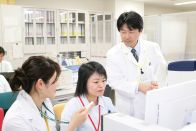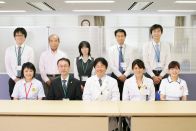| Department of Quality and Patient Safety |
| Director NAGAO, Yoshimasa (Professor) |
| "No advanced medicine without safe medicine" |
| Nagoya University Hospital practices the highest-level advanced medicine in Japan. However, medical practice by its nature is uncertain and risky. We make every effort to minimize these risks and to ensure patient safety. |


Objectives
- Promptly detect various adverse events related to medical practice and make a collective effort to treat patients and save lives.
- Research and analyze accident and incident reporting and provide patients with accurate information. Provide training for the staff and improve the operating system to prevent the recurrence of accidents and incidents.
- Aiming to provide the best possible medical services by objectively measuring the quality of care. Seek the better medical system using improvement science methods.
Operation System
The department consists of a total of 11 members: one professor, one doctor, two nurses, one lawyer and six staff members, in addition to about 120 quality and safety managers in all departments of the hospital. All these people work together for patient safety.
Scope of Medical Services
To provide patients with safe, high-quality medical services, we do the following:
- Establish a hospital-wide system to deal with any matters arising during medical practice.
- Gather and analyze incident reporting from all the departments and improve medical quality.
- Give guidance on third-party objective research into adverse events and on measures to identify the causes and prevent recurrence.
- Compile safety manuals for practice and equipment in the hospital, guides to standards and other necessary literature, and facilitate coordination between departments.
- Provide training to the hospital staff and students to foster safety-conscious medical professionals and create a safety culture.










